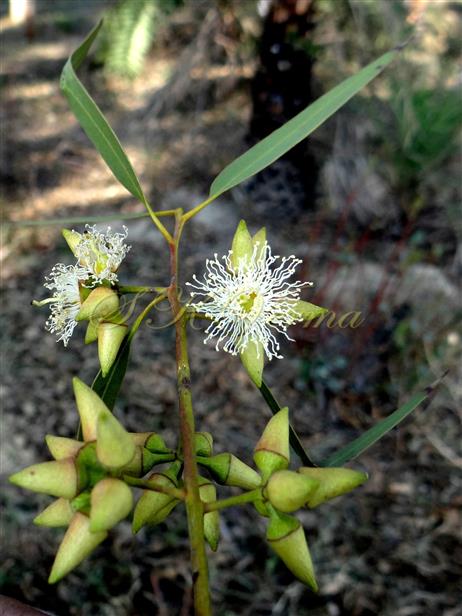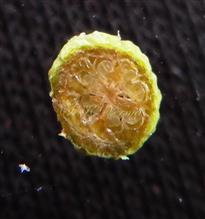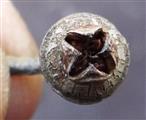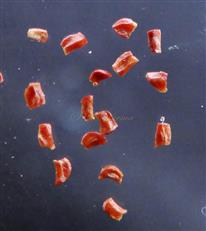EUCALYPTUS
Eucalyptus
L., Heritier, Sert. Angl. 18. 1789; Parker, For. Fl. Punj. ed. 1: 246. 1918 (Reprint 1973); Fl. China @ eFloras.org 13: 321; NSW Fl. Online (PlantNet)
Evergreen trees or shrubs, often forming an underground lignotuber in many species, often large and very large- sized, glabrous, usually secreting aromatic resinous gum. Leaves dimorphic: juvenile leaves (in seedlings) usually opposite and generally of different shapes than that of adult leaves; adult leaves usually alternate, vertical, more or less falcate, gland- dotted, generally thick, penniveined, always with an intra- marginal vein. Inflorescence usually based on condensed dichasia forming umbellasters (also simply termed as umbels), mostly solitary and axillary, sometimes aggregated into compound terminal, pseudo-terminal or axillary structures; individual umbellasters usually 7-flowered, but ranging from 1-30 flowers in some species. Flowers ebracteate, bisexual, actinomorphic, epigynous, mostly white. Hypanthium (or calyx tube) campanulate, obconic or subglobose with apex truncate, adnate to ovate and often produced beyond it; office of hypanthium closed in bud by a cap, the operculum or calyptra (interpreted as representing the calyx limb, petals or both), operculum persists to anthesis and falling as the stamens expand. Stamens numerous, in many continuous whorls arising from the rim of hypanthium, mostly free, usually inflexed in bud; anthers versatile or adnate, small, bithecous, dehiscence longitudinal. Ovary inferior, 2-7- locular, adnate to hypanthium, ovules numerous on axile placentas; style undivided, linear persistent. Fruit a capsule, whole or most of capsule included in expanded hypanthium; capsule opening at top by 2-7 valves, valves exerted from hypanthium, equalling hypanthium rim or included in hypanthium. Seeds numerous, small or minute, many sterile and undeveloped, few fertile, developed seeds ovate or angular, testa rigid, sometimes developed into wings.
712 species
Eucalyptus tereticornis
Eucalyptus tereticornis
Sm., Spec. Bot. New Holland 4: 41. 1795; keralaplants.in; NSW Fl. Online (PlantNet).
A large tree, up to 25 m tall; bark smooth, angular, pubescent when young. Adult leaves alternate, 10-20 cm x 1-3 cm; leaf blade narrow- lanceolate, lanceolate or ovate, usually falcate, coriaceous, gland- dotted, green, concolorous, apex acuminate, base subacute, cuneate or oblique, margin entire; lateral nerves many, pinnate, faint, looped near margin forming intra-marginal nerve; petiole to 2.5 cm long, stout, glabrous. Flowers ebracteate, bisexual, actinomorphic, white, ca. 1.5 cm across, in axillary 4-8-flowered umbellasters; peduncle narrowly flattened or angular, 7-25 mm long; pedicels terete, 3-10 mm long. Floral buds cylindrical or fusiformis, 10-20 mm x 4-8 mm, hypanthium campanulate, ca. 3.5 mm long and across, rugose; operculum conical or elongate acute, longer than and as wide as hypanthium, 1-1.5 cm long. Stamens numerous, in many continuous whorls, arising from the rim of hypanthium; filaments unequal, +/- 6 mm long; anthers small, ca. 1 mm long, versatile or adnate, dehiscence longitudinal. Ovary inferior, adnate to hypanthium, 4-6-locular, ovules many on axile placentas; style simple; stigma capitate. Fruit a capsule, most of the capsule included in expanded hypanthium, to form a hard woody structure; fruit pedicellate, ca. 6 mm in diameter, disc raised or ascending, valves (4-6) exerted. Seeds many, small.
Common Names: Forest Red Gum

.jpg)
-DSC02291 (1).jpg)
 with 2 opened flowers-DSC02298 (1).jpg)
.jpg)
.jpg)
.jpg)

.jpg)
.jpg)




.jpg)
-DSC02291 (1).jpg)
 with 2 opened flowers-DSC02298 (1).jpg)
.jpg)
.jpg)
.jpg)

.jpg)
.jpg)

